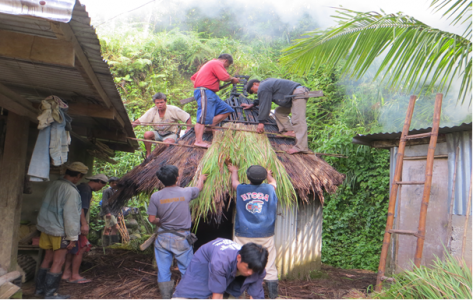Barangay Tonglayan is one among the 11 barangays of Natonin, Mt. Province peopled by indigenous peoples particularly the Hakki tribe. Though the place has steep slopes and mountainous, rice terraces were built by the past generations with their own knowledge and skills. Hence, farming is the main source of living with traditional rice as their primary crop intended for household consumption. Nevertheless, the agricultural situation remains to be “backward”; farming is very arduous due to limited access of community members to appropriate equipment and technologies. It is intensified by increasing number of plant pests and the occurrence of typhoons and drought resulting to low yield. With these unfortunate instances, the people have their own way of coping with their depraved situation by preserving their good traditional farming practices and mutual assistance. In fact, Tonglayan is one of the few communities in the Cordillera that sustain organic farming practices such as planting of traditional rice varieties, observing proper land preparation and use of organic inputs.
Laffot is another traditional practice observed in building of houses and rice granaries. Men are more involve because it requires physical strength in collective gathering of cogon grass which will be used for the roof of a house or rice granary. The gathering of cogon starts early morning at first light just after a “pukkaw” or a shout for call from a designated community member as a signal for the community members to assemble and to collect cogon grass. Cogon grass or scientifically known as the Imperata Cylindrical is under the Imperata genus. This grass grows from 2 to 10 feet and the leaves are around 2 centimeter wide at the base. It is used to thatch the roofing of traditional houses in the Philippines. It is also used for paper making, weaving into mats and bags, and used in traditional medicine. (Reference: http://en.wikipedia.org/wiki/Imperata_cylindrica)
While the community members are gathering and bringing enough cogon grass, the family who asked for help prepares food. Traditionally, whatever is available is to be served but today, a pig must be butchered. After the meal, the setting up or changing of roof begins. First, is to make small bundles of cogon at around 6-7 inches in diameter, then pile it together clipped in sticks and overlaying firmly so that water will not pass through it during the rainy season. With the help of the neighbors, the changing or setting up of a cogon roof is completed in a day. Since the community is prone to typhoons that may destroy roofs, the laffot is widely used to the repair and change dilapidated houses and rice granaries. Cogon grass is considered valuable resource of the community though it is also considered pest when it grows uncontrollable in agricultural areas. With the introduction of weedicides, few farmers use it to eradicate the cogon instead of controlling. The use of weedicides is a threat to the extinction of the cogon grass.
Despite the need of practicing laffot, it is gradually vanishing because of the introduction of technologies affecting the essence of “helping-one-another “such as the use of galvanized iron sheet for roofing which does not entail gathering of grass. Moreover, the absence of elderly to remind this tradition to the younger generations and the introduction of paid labor contributed much in the waning of laffot. The vanishing of good cultural practice is a challenge faced by the indigenous communities at present. For whatever reasons that our cultural practices are affected, the present generation must strive to preserve it. Our cultural practices and beliefs on defending our land and preserving our resources made us differ and unique from others.

